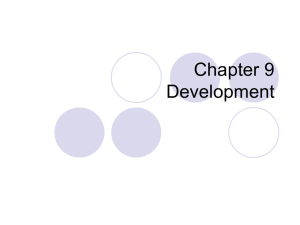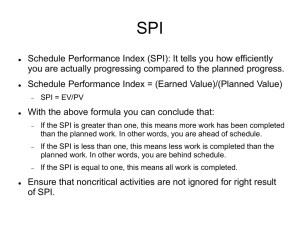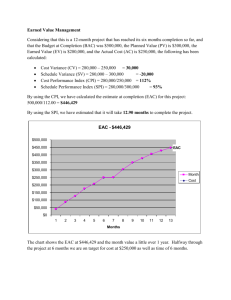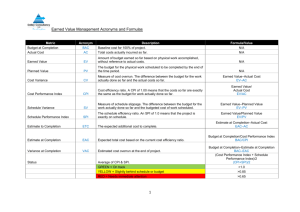Project Management Expect the Unexpected A Project
advertisement
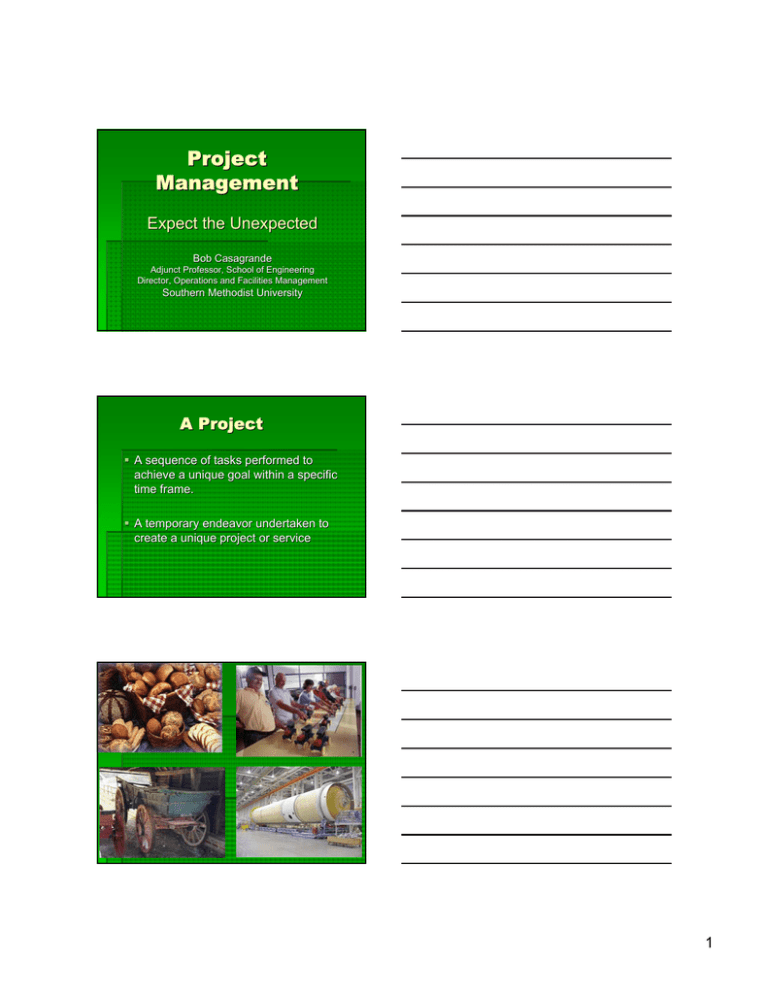
Project Management Expect the Unexpected Bob Casagrande Adjunct Professor, School of Engineering Director, Operations and Facilities Management Southern Methodist University A Project A sequence of tasks performed to achieve a unique goal within a specific time frame. A temporary endeavor undertaken to create a unique project or service 1 Project Management Planning your future outcomes Construction on time and within budget Hitting your target even when it rains Getting it done and still having fun Expecting the Unexpected Assessing the unknown Building and executing excitement Effective project management is the critical difference between a profitable project that meets customer needs and one that is embroiled in seemingly continual difficulties 2 Project Management (A – B) = C2 A New Construction Remodels Renovations Alterations Implementations Plans Programs Schemes Events C B Integration Scope Time Procurement Relationships Communication Quality Costs Risks Cost Overruns Liabilities Change Orders Delays Suits Liens Under Allocations Contract Disputes Errors Adjustments The Profession Began in 1968 Now considered a profession Differentiates a project manager from a functional manager Major fields Construction, architecture, engineering information technology Management Skills Scope Time Cost Procurement Relationships Communication Quality Risk Integration 3 Management Skills Scope Management Used to define the work that needs to be done on any given project Time Management Creating or refining the work breakdown structure, determining dependency relationships estimating the efforts and duration of the tasks and creating the schedule Cost Management Cost categories, estimating use of each resource in each category Fixed and variable cost budgets Management Skills Procurement Management Developing executing and monitoring contracts and purchase orders Relationships Management Identify and stakeholders and their involvement Management Skills Communications Management Most important and most often neglected Who needs what information to what level of detail and what media and time frames. Quality Management Quality planning, Quality Assurance and Quality control 4 Management Skills Risk management Potential risk to a project their likelihood of occurrence Impact to project Prevention and response plans Integration Management Creation of a cohesive comprehensive and well designed project pan and the execution of that plan Resources/Constraints Project Management Triangle 5 Interrelationships of Success Time Cost Quality Resources Scope 5 Project Management Triangle Scope Creep Time Cost Quality Resources Scope What’s in it for me? True or False A) Using project management tools and techniques will guarantee a project’ project’s success B) Using project management tools and techniques doesn’ doesn’t really help; it just adds overhead Project Management Techniques Gantt, PERT and CPM 1800s Henry Gantt Task and Bonus System at Bethlehem steel 1950s Pert -- Program Evaluation and Review Technique used network diagramming CMP Critical Path diagramming called activity on node longest path 6 Project Processes Planning Initiating Executing Controlling Closing Initiating One single process that is authorizing the project or phase Planning Process Core processes Scope Planning Definition Activity Definition Sequencing Duration Schedule Development Cost Estimating Budgeting Risk Mgmt Planning Resource Planning Project Plan Development Quality Planning Organizational Communication Risk identification Qualitative risk analysis Quantitative Risk analysis Risk response planning Procurement Solicitation 7 Executing Process Execution Quality assurance Team development Information distribution Solicitation Source selection Contract administration Controlling Process Integrated Change Control Scope verification Schedule Control Cost Control Quality Control Performance Reporting Risk Monitoring Reporting Closing Process Contract Closeout Administrative Closure 8 Life Cycle Percent Complete Stage 4 Stage 3 Stage 2 Stage 1 Life Cycle Fully Operational Percent Complete Substantial Completion Project ‘Go’ Decision Let Major Contracts Stage 4 Stage 3 Stage 1 Stage 2 Stage 1 Feasibility Project Formulation Feasibility Studies Schematic Design and approval 9 Stage 2 Planning & Design Design Development Detailed Planning Cost and Schedule Contact Terms and Conditions Stage 3 Construction Construction Manufacturing Delivery Civil Works Installation Testing Stage 4 Turnover and startup Final testing Commissioning Operations and Maintenance Submittals AsAs-built plans Warrantees Specifications 10 Life Cycle Fully Operational Percent Complete Substantial Completion Project ‘Go’ Decision Let Major Contracts Stage 4 Stage 3 Stage 1 Stage 2 Ability to influence project quality cost and schedule Cost to implement changes in quality cost and schedule High Low Project definition Schematic Design Design Development Procurement Construction Measures of Success Traditional Measures On Time Value Measures Scope Were project goals met? Quality Within Budget Was client satisfied? Resources Were there casualties either to the team or to interrelationships? 11 Measuring Performance SPI Schedule Performance Index CPI Cost Performance Index CPI Earned work hours or dollars to date (EV) Actual work hours or dollars to date (AC) Comparison of the number or work hours being spent on work tasks to the hours budgeted It is an indicator of productivity SPI Sum of Earned work hours to date (EV) Sum of scheduled work hours to date (PV) The amount of work performed to the amount scheduled to a point in time 12 Indices Interpretations CPI > 1.0 Overestimated amount of effort required Measurement of percent of completion is too optimistic Better than planned productivity CPI <1.0 Underestimated amount of effort required Measurement of percent completion too pessimistic Poorer than planned productivity Indices Interpretations SPI > 1.0 Started work prior to or out of sequence to logical restraints Better than planned productivity resulting in activities complete early Working on critical activities SPI < 1.0 Understaffing or under equipping activities Delayed in starting of activities Work is more difficult than planned Improper sequencing of activities Work is disorganized Success Formula Project A temporary endeavor undertaken to create a a unique project or service P- MGMT –Managing the process to successful completion Process – Initiating, planning, executing, controlling & closing MGMT skills – integration, scope, time, communication, procurement, quality, Relationships, cost & risk Life Cycle – feasibility, planning & design, construction, turnover and startup Measure your success SPI, CPI etc. Expect the Unexpected 13 Project Management Expect the Unexpected Bob Casagrande Adjunct Professor, School of Engineering Director, Operations and Facilities Management Southern Methodist University 14




